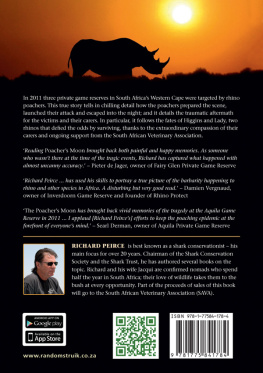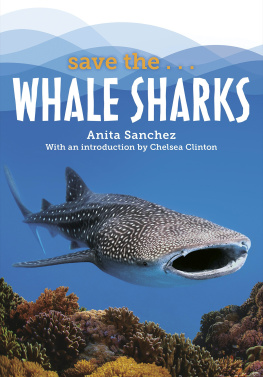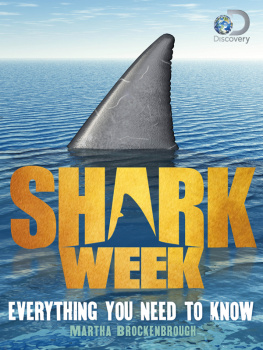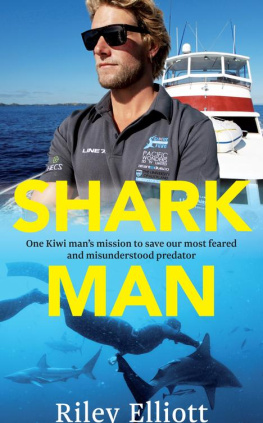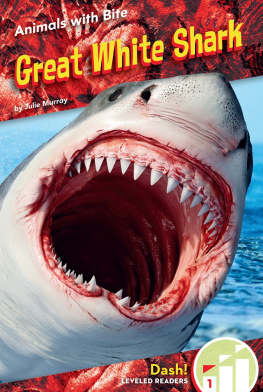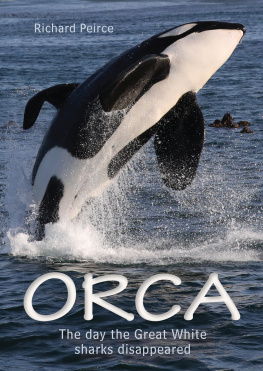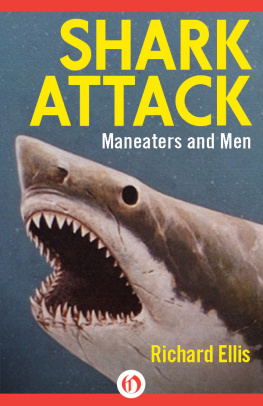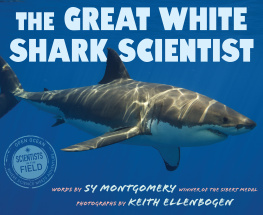
DEDICATION
This book is dedicated to Nicole and to all the worlds Great White Sharks, and is written in the hope that conservation efforts achieve a secure future for these amazing and wonderful yet endangered animals.
Published by Struik Nature
(an imprint of Penguin Random House South Africa (Pty) Ltd)
Reg. No. 1953/000441/07
The Estuaries No. 4, Oxbow Crescent,
Century Avenue, Century City, 7441
South Africa
PO Box 1144, Cape Town, 8000 South Africa
Visit www.penguinrandomhouse.co.za and join the Struik Nature Club for updates, news, events and special offers.
First published in 2017 by Struik Nature
Copyright in text, 2017: Richard Peirce
Copyright in maps, 2017: Richard Peirce
Copyright in published edition, 2017:
Penguin Random House South Africa (Pty) Ltd
Publisher: Pippa Parker
Editor: Helen de Villiers
Designer: Janice Evans
Photographers: Michael Scholl and Harry Stone;
Heather Fener (research expedition photos);
or as individually credited
Cartographer: Liezel Bohdanowicz
Proofreader: Thea Grobbelaar
All rights reserved. No part of this publication may be reproduced, stored in a retrieval system, or transmitted, in any form or by any means, electronic, mechanical, photocopying, recording or otherwise, without the prior written permission of the copyright owner(s).
Print: 9781775845348
ePub: 9781775845355

The images of sharks and fins in this book are mainly for illustrative purposes and do not necessarily portray Nicole; when they do, the image is labelled accordingly.
Every effort has been made to trace and credit the owners of images used in this book we apologise if any have slipped in that are unattributed or wrongly so.
image: Michael Scholl
Contents
Forewords
IN 1997 I LEFT MY FAMILY AND COUNTRY and moved to South Africa just three years after Nelson Mandela had swept to electoral victory as the head of the newly named Rainbow Nation. At the time shark enthusiasts the world over had become acquainted with the names Dyer Island and Shark Alley thanks to a BBC Wildlife documentary, and the little town of Gansbaai on South Africas southwestern coast was just beginning its journey to fame.
After I arrived in South Africa, there followed 10 blissful years of living and breathing (and sweating and laughing) Carcharodon carcharias , the Great White Shark. My move was timely because until then almost no research had been done on the species, which had recently been granted protection in South African waters. From my lounge window I could watch whales while drinking my coffee, and a half-hour boat ride took me to the waters around Dyer Island, and the largest population of Great White Sharks in the world.
I felt lucky and privileged, almost like an explorer from a bygone age, as I settled in and initiated a population study of these elusive and misunderstood animals. The internet had been born only a few years earlier, GoPros didnt exist even in the wildest geek dreams, and neither National Geographic nor Discovery Channel had started their shark broadcasting blitz.
It quickly became clear that identification tagging Great White Sharks had its limits, but as an avid photographer I soon realised that there was another way to identify individual sharks. Side-on shots of dorsal fins provided reliable fingerprint-style identification, and I continued this work for several years, refining it all the time.
Day after day I photographed and observed these hollow-eyed, man-eating, prehistoric monsters, and day after day their behaviour astonished me and dispelled the popular myths. They demonstrated individual behavioural traits showing different personalities and often exhibiting great curiosity. I observed social interaction, and the individual sharks were often very relaxed and seemed as interested in observing us as we were in watching them. It might sound far-fetched, but on many occasions when they spy-hopped and looked at us, I couldnt help thinking that if they had cameras, they would have been photographing us!
Those close to me are aware of my obsession with Nicole and many would use the word love to describe the way I talk about her. For five years she was almost like a shark wife, as every year she came back to Dyer Island for a few months and presented her distinctive fin, swam curiously around my boat, and looked at me with her beautiful dark blue eyes. Little did I know when I first saw her in 1999 that she would become the most famous shark in the world and would help protect her species.

Shark Alley flows between Dyer Island and Geyser Rock.
Nicoles incredible story is one of survival and inspiration, but it is also the story of the humans who studied and came to know her and, as a result, now understand her species better. I have been friends with Dr Ramon Bonfil for many years, and each time we meet, Nicole is always part of the conversation. I will always be very thankful to him for having enabled our team of South Africa-based scientists to have access to satellite-tagging technology in those early days. Nearly two decades after I last saw Nicole, I have moved away from research and into conservation, and I still feel privileged to be living my dream by working at the Save Our Seas Foundation. The Foundation came into being shortly before Nicole was tagged, and in a way we continue to follow the example of her story by helping to fund research that leads to effective conservation.
Despite the innumerable documentaries that give the impression that we know everything there is to know about sharks, many of the 1,200 shark and ray species remain a complete mystery to us today. The Foundation supports education, research and conservation projects worldwide to help better understand these creatures that are so important for maintaining the delicate balance of our oceans.
Nicole is an extraordinary book. At one level it tells the simple tale of a fish that swam 22,000 kilometres and yet it is also far more than that. Richard Peirce narrates Nicoles story in an interesting and compelling way, personifying her and leaving readers in little doubt that in some ways he considers her superior to humans.
For the rest of my life I will feel proud and privileged that I knew Nicole and played a part in telling her story to the world. My most precious dream is that she continues to roam our oceans and has not become a victim of mans destructive influence on our seas. I still fervently hope that someone, somewhere has taken, or will take, a photograph of her distinctive dorsal fin and will share it with me.


The waters around Dyer Island are home to the worlds largest population of Great White Sharks.

If people find the image of a fin slicing through the water frightening, how much more ghoulish is the image of a fin being hacked off to put into a bowl of soup?
Next page

